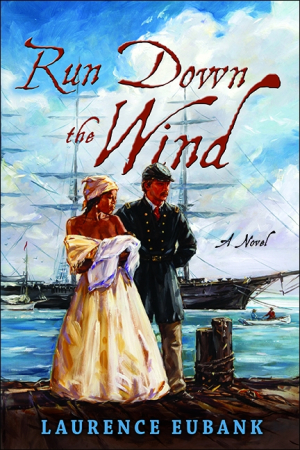
Run Down the Wind
Meticulously researched, sweeping Civil War epic paints a picture of nineteenth-century America as anything but simple black and white.
Run Down the Wind, a romantic historical novel by Laurence Eubank, is a coming-of-age story that follows the escapades of two youths, Lester Norton of Maine and Jubal Calhoun of Alabama. They go to sea in their mid-teens, grow to manhood, enter business together, and ultimately find brides and deal with the enormous dislocation of the War Between the States. As Lester notes, after a particularly successful trading journey to England in 1853, “Come a long way, we have … Right hands to the most respected shipping men in the world.”
It stretches credulity a tad, however, that these two young people become so successful so soon, having started out hardly three years prior as teenagers with little schooling or business sense. Still, Eubank has researched this story in great detail. For instance, Cahaba is Jubal’s hometown, and the location figures prominently in this swashbuckling epic that recounts events in American history during the middle of the nineteenth century. In reality, Cahaba is the name of a river in Alabama, the name of the first capitol of the state, and the site of a Confederate prison during the Civil War that housed nearly three thousand Union soldiers.
There is a wealth of factual material delivered along with the story. In fact, sometimes the background material slows down the action of the narrative. During the early chapters, the reader is pummeled with more intricate descriptions of the riggings of mid-century sailing ships than is really necessary. Fortunately, the author has included a chart depicting the names of each of the principal sails in a three-masted sailing ship of that time. And Eubank keeps the action moving and the reader engaged.
The book is clear that the moral and economic realities of the world in the nineteenth century are anything but black and white. It explains the practice of the British forcing open the China trade in order to buy tea and paying for it with opium. In the American South, Lester is indignant about doing business with slaveholders, only to be reminded the credit and shipping that drives the cotton market comes from New England businessmen, who profit greatly from the agricultural system so dependent on slaves. Eubank masterfully creates a murky world in which the story unfolds. Even Emma, Jubal’s sister’s mother, is described as an octoroon (one of many categories once assigned to those with mixed-race ancestors).
On occasion, the narration becomes bogged down in dialect. Whitmill Rivens, a horrible person in Jubal’s family, tries to explain particularly dark events of the past by saying, “Jes look at ‘er, boy! Yew took her early, broke her in good! Her maw come sassed me, that Beulah bitch with her. Couple teeth weren’t ’nough for one, ’n the mother thinking she gonna tell me what I can do with the daughter.” The Calhoun family history is indeed twisted and gothic, though some readers may find dialect-heavy moments such as this hard to get through.
Run Down the Wind is a monumental piece of writing extending more than five hundred pages, but is worth every ounce of effort it takes to finish. Eubank has hinted at a sequel, which also should be entertaining.
Reviewed by
John Senger
Disclosure: This article is not an endorsement, but a review. The publisher of this book provided free copies of the book and paid a small fee to have their book reviewed by a professional reviewer. Foreword Reviews and Clarion Reviews make no guarantee that the publisher will receive a positive review. Foreword Magazine, Inc. is disclosing this in accordance with the Federal Trade Commission’s 16 CFR, Part 255.
